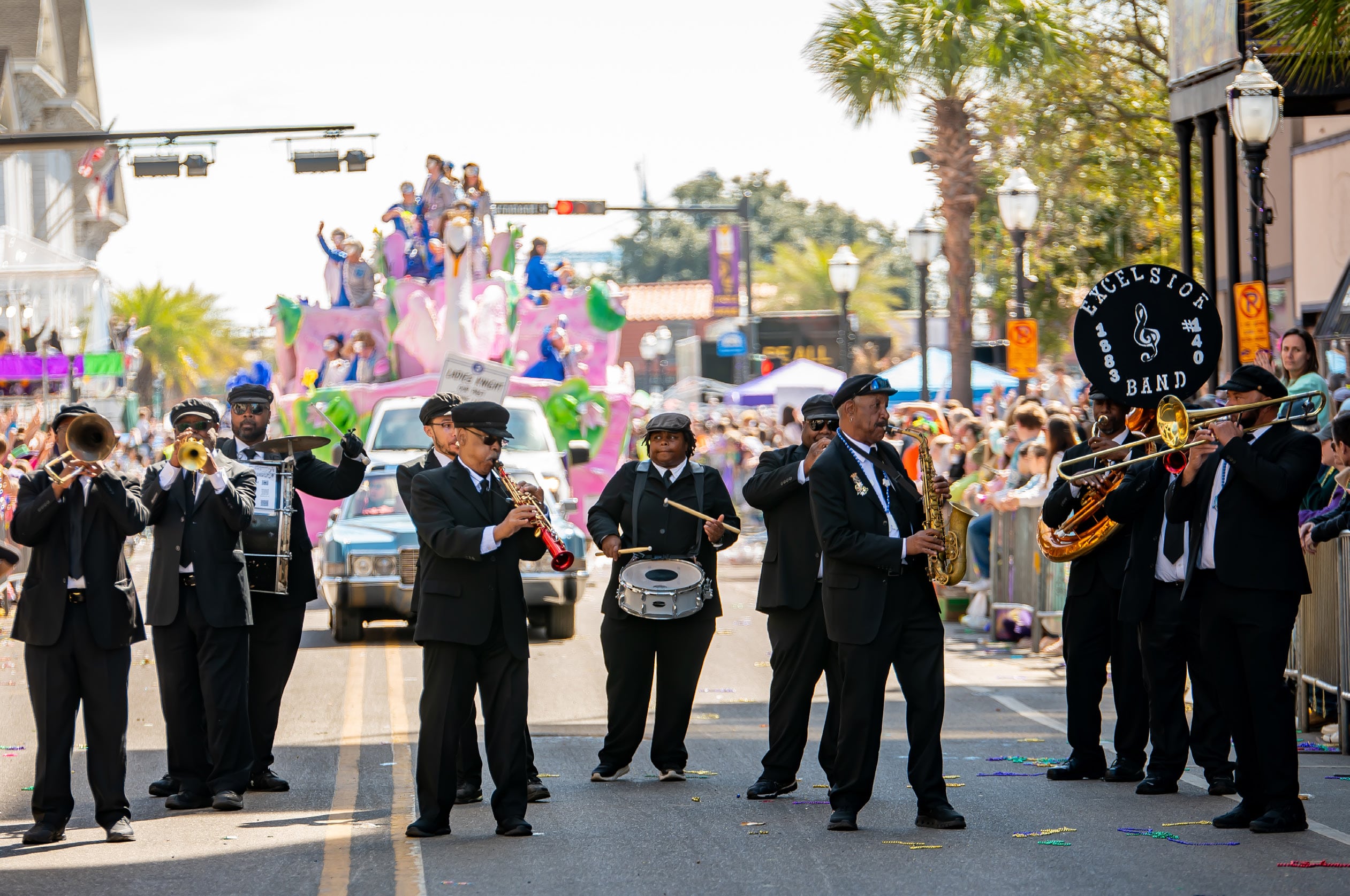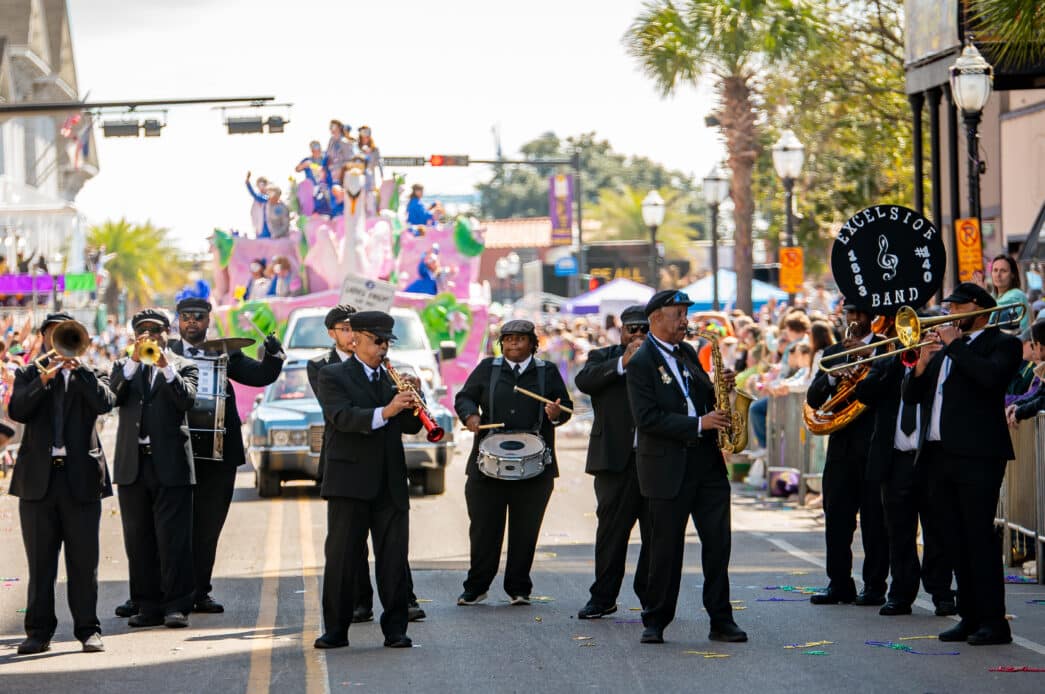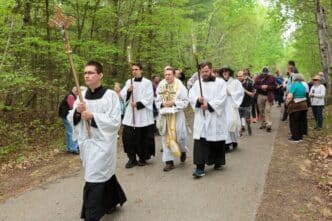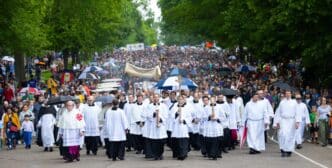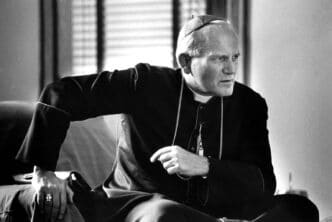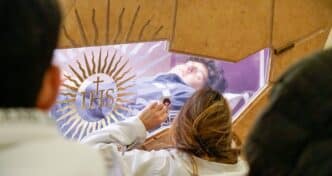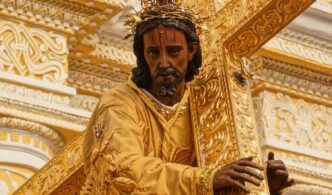This article first appeared in Our Sunday Visitor magazine. Subscribe to receive the monthly magazine here.
Twenty-five years ago, when Brendan visited Mobile for the first time — for a job interview — the cabbie asked if Mardi Gras was the reason for traveling to Alabama’s Port City.
It seemed like an odd question. It’s not surprising that hotel rooms would be hard to come by during the carnival season, but surely people weren’t booking rooms 145 miles away from New Orleans, were they?
We eventually would come to learn that Alabama’s oldest city has a long-running Mardi Gras tradition separate from the better-known festival that its Louisiana cousin throws each year. Such a long-running carnival, in fact, that Mobile claims it as America’s original Mardi Gras.
It is, without a doubt, what Mobile is “known for.” And yet, large swaths of America don’t know Mobile at all. We didn’t either before moving here.
It is a city that will delight and surprise the visitor — particularly the Catholic visitor. Before we moved here, we lived in Hagerstown, Maryland, a Protestant town in a Catholic state. When we came South, we ended up in a city with a deep Catholic history in an overwhelmingly Protestant state.

Mobile dates back more than three centuries, with a history that saw it repeatedly swap hands — from the French to the British to the Spanish to the Americans. Its Catholic roots can be seen today. A modern city of 200,000, it has the largest concentration of Catholics in an otherwise Evangelical-dominated Alabama. The Archdiocese of Mobile, which stretches well beyond the Gulf Coast, counts 105,000 Catholics. The majority live in the two coastal counties: Mobile County and Baldwin County to the east.
“The type of enthusiasm here … God has been very good to our archdiocese,” Mobile Archbishop Thomas Rodi said during an interview in a cozy room in the Church’s downtown offices.
An evolving feast
Mardi Gras, French for “Fat Tuesday,” has been commemorated in Europe and the Western Hemisphere for centuries. It is not a Catholic holiday. But as Mardi Gras expert Steve Joynt told us in a phone interview, it “grew up in the shadow of the Catholic Church,” based on the liturgical calendar.
Joynt, whom we worked with at the Press-Register newspaper, founded a publication and website called “Mobile Mask” to chronicle all things Mardi Gras. He notes that the celebration’s medieval roots date to 13th-century Europe, when butchers rebelled against the loss of business during the 40-day period of austerity between Ash Wednesday and Easter.
“It was about overindulging in meat” during the weeks before Lent, Joynt said. It eventually would come to involve overindulgence in just about any vice. In many places, it was quite a bawdy affair.
“It was really a license for you to act up and get things out of your system,” Judi Gulledge told us in her office next to Mobile’s must-see Mardi Gras Museum, where she is executive director. She also serves as head of the umbrella group of carnival organizations called the Mobile Carnival Association, which each season crowns a young man King Felix III and selects a woman as his queen.
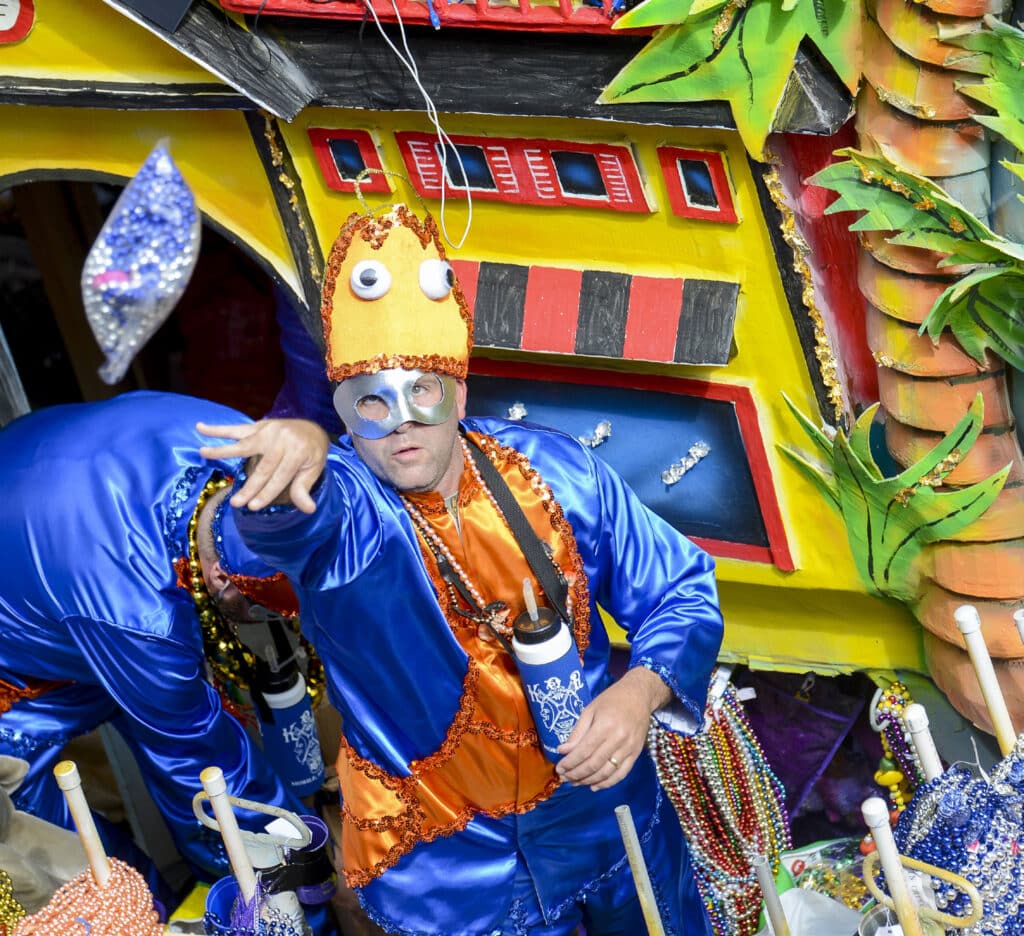
Today, in Mobile at least, Mardi Gras is a far tamer, family-friendly experience. For three weeks, carnival organizations stage balls for their members and guests, and parade through the streets for the general public. Masked men and women dressed in elaborate costumes and riding on even more elaborate floats throw beads, candy, Moon Pies and other treats and trinkets to thousands of eager parade-goers.
“Mardi Gras is a celebration put on for the people by the people,” said Gulledge.
The basic structure of Mobile’s Mardi Gras resembles the holiday that people are familiar with in New Orleans, but with several unique Mobile twists. Perhaps the most important of those twists is Joe Cain, a 19th-century Mobilian widely credited with reviving Mardi Gras celebrations after the Civil War. According to the mix of history and legend that surrounds the tale, he dressed as a Chickasaw chief named Slacabamarinico and marched through the streets on Fat Tuesday in defiance of occupying Union soldiers.
To this day, someone portraying Joe Cain dons Indian garb and leads the “People’s Parade” on the Sunday before Mardi Gras day. On that same morning, people can watch another uniquely Mobile spectacle: the wailing of Joe Cain’s widows. Women dressed head to toe in black gather to argue with one another over which one Joe loved the most. Some years ago, a second group of women — dressed all in red — began showing up declaring themselves Joe Cain’s mistresses. It’s amusing and completely devoid of historical fact. As far as anyone knows, Joe Cain never had more than one wife and had no mistresses.

Mobile predates New Orleans and, therefore, its observance of Mardi Gras undoubtedly predates that of the Crescent City. But the modern celebration, with floats and “throws,” began first in New Orleans. It was Joe Cain, during a trip to New Orleans in 1867 with his fire company for the annual fireman’s parade, who brought back the idea of holding parades on Fat Tuesday. On the other hand, New Orleans borrowed the idea of elaborate parading societies from Mobile, where such groups began holding New Year’s Eve parades in the early 19th century. It’s an illustration, Joynt says, of how intertwined the Mardi Gras histories of the two cities are.
Culinary firsts
The annual Mardi Gras holiday draws a million visitors a year to Mobile, and the city’s tourism agency markets it to outsiders all year long. But Visit Mobile President and CEO David Clark, speaking to us in a conference room atop the Arthur R. Outlaw Mobile Convention Center, says the city is about so much more than Mardi Gras. He has no problem answering when asked what visitors and tourists know about Mobile that natives don’t.
“That there’s a lot more to do,” he says.
Adds Ashley Rains, senior public relations and communications manager for Visit Mobile, “I kind of roll my eyes when I hear people say, ‘There’s nothing to do in Mobile.’ Because when we bring visitors to Mobile, they’re like, ‘I don’t have enough time to do everything that I want to do, everything that I’m discovering.”
Chris Andrews told us in a phone interview that has also been his experience with Bienville Bites, a food-and-history tour that he started with his wife in 2017.
“The feedback that I hear every single time is, ‘Wow, we had no idea. We’ve driven through Mobile my whole life, and I had no idea all this was here,'” says Andrews, author of “A Culinary History of Mobile,” who also does a podcast called Port City Plate. “And they can’t believe that it’s as nice as it is, that it’s historic.”
Customers get to sample food from several restaurants and listen to Andrews or another guide tell stories about Mobile’s history. They eat delicious food amid unforgettable ambiance. Take two venues in just one building, the 34-story RSA Trustmark Building. Both are restaurants owned by former University of Alabama and Miami Dolphins football star Bob Baumhower.

Dauphin’s sits on the top floor, with stunning, panoramic views of the city and surrounding area. Las Floriditas, meanwhile, is in the basement, in what used to be a bank vault. It has a Cuban speakeasy theme, down to a requirement that customers give a password (it’s available each day on the restaurant’s Facebook page). Give the correct answer, and a bookshelf slides open to reveal a restaurant that often hosts live music.
Andrews said it’s not just Mardi Gras that debuted in Mobile before New Orleans.
“A lot of things that New Orleans gets credit for probably happened here in Mobile first. … Not just on Mardi Gras but also with food,” he says. “A lot of dishes, like gumbo and jambalaya and po’ boys — a lot of those foods were probably consumed in Mobile before New Orleans.”
Diverse Catholic heritage
To the Catholic visitor, Mobile offers more than just historic sites. For instance, the grand Cathedral-Basilica of the Immaculate Conception in the heart of downtown Mobile isn’t just an attraction in its own right. It’s a working church with daily and weekly Masses.
Archbishop Rodi told us that for the first 120 years, the cathedral was the only church in town. For decades, in fact, Mobile was part of the Archdiocese of Quebec under French rule, and then later the Archdiocese of Santiago, Cuba, under Spanish rule.
Mobile’s first bishop, Michael Portier, presided over a diocese that, in the 19th century, was vast in geography but sparse in population. It had just three churches: one each in Mobile; Pensacola, Florida, and St. Augustine, Florida. According to Archbishop Rodi, Bishop Portier would ride a horse between Mobile and St. Augustine. The 450-mile journey would take two weeks, and the bishop would try to find cabins to stay in along the way.
“If there were no cabins, he would sleep outside with the snakes, mosquitoes and alligators,” Archbishop Rodi said.

The Catholic Church in Mobile lived up to its moniker, “the universal church,” even through the tumultuous civil rights era. The Jesuit-run Spring Hill College admitted its first Black students in 1954, nearly a decade before George Wallace’s infamous “stand in the schoolhouse door” at the University of Alabama.
The cathedral in Mobile is part of the local African American Heritage Trail, not only for its long legacy of having Black members but for its practice of recording baptisms of Black babies — by name, not simply age and sex, as was the common practice in the South during the 18th and early 19th centuries.
The nationally regarded Civil Rights Memorial Center in the state capital of Montgomery, which is within the Archdiocese of Mobile, tells the story of the City of St. Jude Parish offering shelter to the Selma marchers in 1965.
“Quite frankly, they couldn’t find anywhere else to stay,” Archbishop Rodi said. “Archbishop (Thomas) Toolen was instrumental in this. And the parish paid a price, as much of the monies donated to the parish’s hospital and social services dried up as a result.”
That’s not to say the Catholic Church within Mobile was immune to the racial practices of the region. As with Mardi Gras, which featured separate white and Black carnival associations and celebrations, Mobile had separate Black and white churches.
The influence of that past shapes both institutions today, although the legacy is waning. Archbishop Rodi says the Mobile diocese has nine parishes that are historically Black. But membership has changed these days. The Shrine of the Holy Cross, founded in 1948 as a Black mission church in suburban Daphne, now has a diverse congregation.
The same might be said for Mardi Gras itself. In Mobile, there are two umbrella organizations: the Mobile Carnival Association, which is a clearinghouse for the historically white mystic societies, and the Mobile Area Mardi Gras Association, the black Mardi Gras organization. MAMGA’s current president, Isadore Sims, recalled during a phone interview that when the first black carnival group formed in 1938, African Americans were not allowed to come downtown to participate in Mardi Gras.
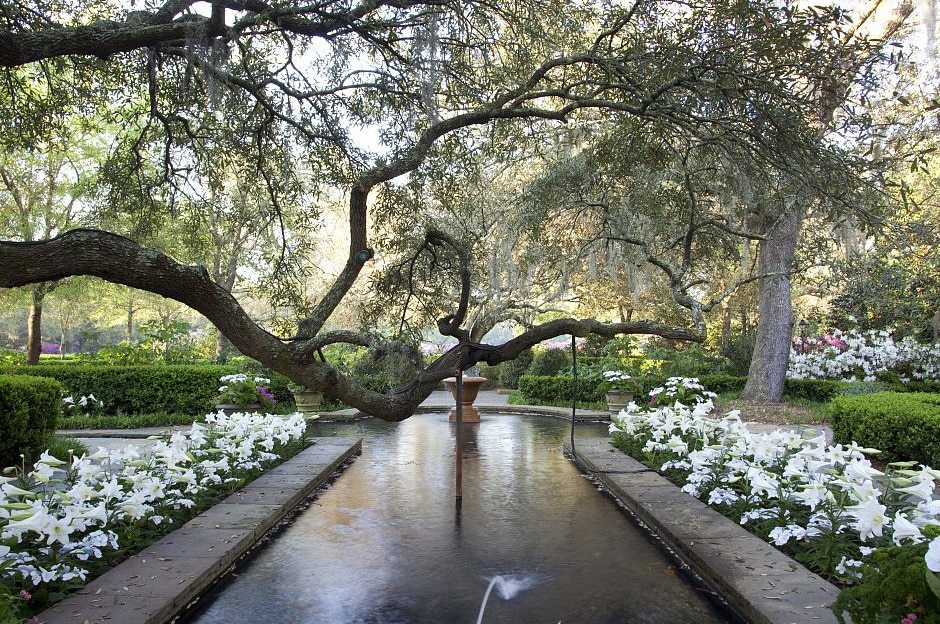
Back then, Sims says, the organization allowed African Americans to experience Mardi Gras in a segregated city, and he adds that Catholics played a large role. The city’s first Black Mardi Gras king, Alex Herman, was a Catholic. Ever since, the king has been dubbed King Elexis I, taken from his name. (His daughter, Alexis Herman, was a MAMGA Mardi Gras queen who served as labor secretary in the Clinton administration.)
“Everybody has their particular traditions,” Sims says. “Without upholding tradition, you lose who you are.”
Yet, he says the segregation that once marked Mardi Gras is long gone.
Nowadays, it’s difficult to envision a segregated Mardi Gras, given the mix of faces in the parade crowds throughout the city and greater area (there are parading organizations in other parts of Mobile County and neighboring Baldwin County).
Sims says that 3,000 people of all ethnicities and walks of life attend MAMGA balls. And there is strong solidarity between the white and black carnival organizations.
“Whether it’s MAMGA or MCA, at the end of the day, it’s a family,” he says. “We support each other in various forms.”

